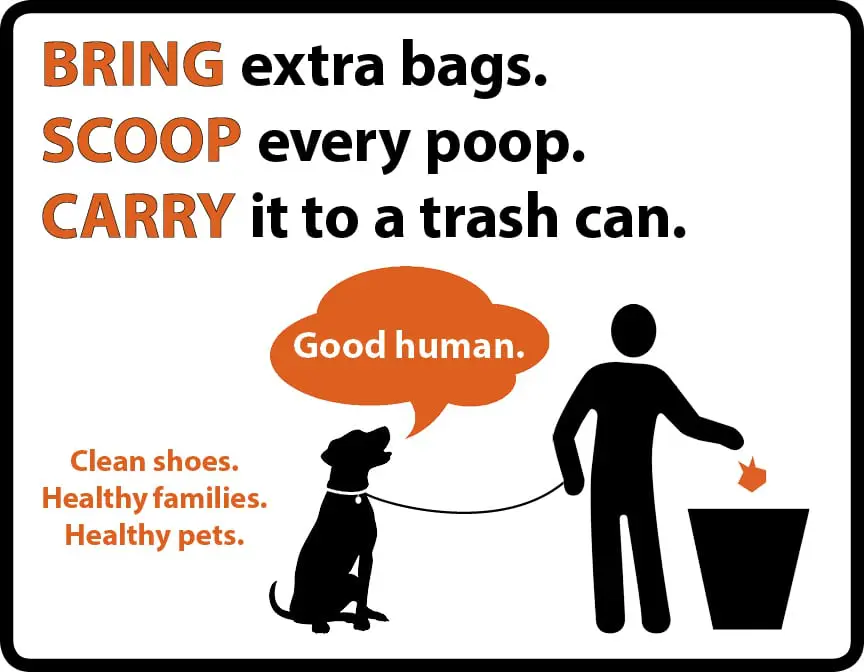Veterinarians and waste haulers agree: the trash is the safest place to dispose of your pet’s waste.
Pet waste is raw sewage that can spread disease
Pet waste can contain disease-causing organisms, including roundworms, Giardia, Salmonella, E. coli, Cryptosporidium, Toxoplasma and Parvovirus. Even when pet waste looks like it has washed away, many of these pathogens can survive for days, weeks or months in soil and water waiting for a host. People and pets can come into contact with pathogens found in pet waste while playing in grass, gardening, swimming, fishing, or boating.
Harmful levels of fecal coliform bacteria have been found in all the urban creeks in Bellingham, making them unsafe for recreation. High levels of fecal bacteria can also cause closures in commercial shellfish beds and spread illnesses to pets and wildlife. In addition, the nutrients in pet waste can create harmful algal blooms in lakes that turn the water green and cloudy, kill fish and make it unappealing for swimming and boating.

Dogs at Home
Pick up dog poop at home at least weekly, bag it, and place it in the trash. Most Bellingham dog owners scoop the poop at least weekly. Set up a poop scooping system that works for you, such as scooping with a shovel or rake and dumping it in a bag-lined bucket or long-handled bin (example in image at right). The biggest scooping challenges dog owners face are making time to scoop regularly and keeping up when it’s dark, cold or rainy. When it’s rainy, scoop poop as soon as possible to prevent disease-causing organisms from running off into streams or hatching eggs in the soil. Think about your schedule and plan ahead for a regular time in the week you can scoop. If you can promise to scoop at home at least weekly, make the We Scoop Pledge today. We’ll send you a free flashlight and bag dispenser for your leash, and a We Scoop sticker for your trash can.
Dogs on Walks

When out on walks in parks or trails around your neighborhood, always bring more bags with you than you think you’ll need, just in case. Keep a flashlight on your leash to help find droppings after dark. Scoop every poop, and carry it to a trashcan. Never leave bagged poop on the side of the trail. Even if you intend to pick it up on your way back, bagged poop on the side of the trail is unsightly litter that frustrates other people and is often forgotten about. Some parks and trails provide poop bags and trash cans, but it is your responsibility to come prepared and remove your dog’s waste at all times.
In off-leash areas it is especially important to keep a close eye on your dog. Even if your dog poops far from the beaten path in tall grass or bushes, it is still important to scoop. Pathogens found in dog poop can survive in the soil and be spread by animal feet and rain to people, pets, and wildlife.
You Can Help!
- Make the We Scoop pledge to get a free Poop Scooping Toolkit and enter our dog photo contest!
- Visit our Scoop the Poop Facebook page and help us spread the word, not the turd.
- Put a We Scoop sticker on your curbside trash cans to show your neighbors what to do.
- Join a We Scoop Park Cleanup work party. Contact pkvolunteers@cob.org for more information.
- When you’re out walking, give bags to dog walkers who don’t have them and thank those who do.
Outdoor Cats & Other Contributors
Outdoor cats can be trained to use a litter box. Cat waste and used litter should be put in a sealed bag and then in the garbage. The sewer system is not designed to handle cat litter or cat waste.
Wildlife, such as deer, raccoons, and geese, can also contribute unhealthy levels of waste if their populations are concentrated. Avoid attracting wildlife to your home or parks. Never feed wildlife and keep trash and pet food well sealed. Healthy watersheds are able to handle natural levels of animal waste without damage to water quality.
Other sources of fecal coliform bacteria include leaking sewers, failing septic systems, and homeless encampments.
The City’s efforts to lower fecal coliform levels in our urban streams include the pet waste management program; regular clean-up of mapped homeless encampments as well as efforts to match homeless community members with appropriate social services, the Urban Streams Monitoring program, and habitat restoration studies and projects.
